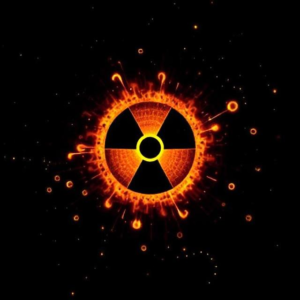Radioactive Decay and Half-Life: Explanation
Radioactive decay is a natural process by which an unstable atomic nucleus loses energy by emitting radiation. This decay results in the transformation of the nucleus into a different element or isotope.

What is Radioactive Decay?
- Atoms are made up of a nucleus, which contains protons and neutrons. In some elements, the nucleus is unstable, meaning it doesn’t have the right balance of protons and neutrons.
- To become more stable, these unstable atoms will decay or break down by releasing energy in the form of radiation. This process is known as radioactive decay.
- When a nucleus decays, it can emit:
- Alpha particles (made of 2 protons and 2 neutrons),
- Beta particles (electrons or positrons),
- Gamma rays (high-energy electromagnetic radiation).
As a result of this decay, the atom transforms into a different element or a different isotope of the same element.
Types of Radiation Emitted During Decay:
- Alpha Decay: The nucleus loses two protons and two neutrons, resulting in the emission of an alpha particle.
- For example: Uranium-238 decays into Thorium-234.
- Beta Decay: A neutron in the nucleus turns into a proton, releasing an electron (beta particle).
- For example: Carbon-14 decays into Nitrogen-14.
- Gamma Decay: The nucleus releases gamma rays (electromagnetic radiation) to lose excess energy without changing the number of protons or neutrons.
- For example: Cobalt-60 emits gamma radiation as it decays into Nickel-60.
What is Half-Life?
The half-life is a term used to describe the time it takes for half of the atoms in a sample of a radioactive substance to decay. This concept is important because radioactive decay is random and happens at a constant rate for each type of radioactive material.
- For example, if you have 1000 atoms of a radioactive material and it has a half-life of 1 year:
- After 1 year, half of them (500 atoms) will have decayed.
- After 2 years, half of the remaining 500 atoms (250 atoms) will decay.
- After 3 years, half of the remaining 250 atoms (125 atoms) will decay, and so on.
How Does Half-Life Work?
- Constant Rate: The half-life is the time it takes for half of the remaining radioactive atoms to decay, no matter how many times you repeat the process.
- Random but Predictable: While it’s impossible to predict which specific atom will decay next (since it’s a random process), we can predict how long it will take for half of a large group of atoms to decay on average.
Key Points About Half-Life:
- Unique to each isotope: Different radioactive materials have different half-lives. For example, Uranium-238 has a half-life of 4.5 billion years, while Carbon-14 has a half-life of about 5730 years.
- Decay is not instantaneous: At any given moment, some atoms may decay quickly, while others may take a long time. However, the average time it takes for half of the atoms to decay is constant and is called the half-life.
Example: Carbon-14 and Dating
One of the most well-known uses of half-life is in carbon dating, a method used by scientists to determine the age of ancient objects, like fossils or artifacts.
- Carbon-14 is a radioactive isotope of carbon that is found in the atmosphere. Living organisms constantly take in carbon-14 from the air during their lifetime. However, when the organism dies, it stops absorbing carbon-14.
- Over time, the carbon-14 in the remains decays into nitrogen, and because we know the half-life of carbon-14 (5730 years), scientists can measure how much carbon-14 remains and determine the age of the object.
Example with a Different Half-Life:
Let’s take an isotope like Iodine-131, which has a half-life of 8 days.
- If you start with 1000 atoms of Iodine-131:
- After 8 days (one half-life), you’ll have 500 atoms left.
- After 16 days (two half-lives), you’ll have 250 atoms left.
- After 24 days (three half-lives), you’ll have 125 atoms left, and so on.
Why is Half-Life Important?
- Radiometric Dating: Half-life is used in radiometric dating techniques to determine the age of rocks, fossils, and other materials.
- Medical Use: Certain radioactive isotopes with short half-lives are used in medical imaging and cancer treatment. For example, Iodine-131 is used in thyroid treatments.
- Nuclear Waste: Understanding the half-life of different radioactive materials is important for handling and storing nuclear waste safely.
Summary of Key Points:
- Radioactive Decay: The process by which unstable atomic nuclei break down by emitting radiation (alpha, beta, or gamma particles) and transform into a more stable element or isotope.
- Half-Life: The time it takes for half of the radioactive atoms in a sample to decay. It’s a constant rate for each substance, and helps scientists measure how long it will take for a given amount of a radioactive material to decay.
- Usefulness of Half-Life: The concept of half-life is crucial for:
- Dating ancient objects (carbon dating).
- Understanding the behavior of radioactive materials.
- Medical applications (like cancer treatment).
- Managing nuclear waste.











